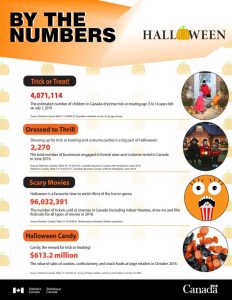Halloween Tricks and Treats
 There is a lot of discussion these days about whether or not Halloween will be celebrated in 2020. Worries about children missing out on the fun and candy makers fussing over lost profit makes one wonder about how this holiday evolved.
There is a lot of discussion these days about whether or not Halloween will be celebrated in 2020. Worries about children missing out on the fun and candy makers fussing over lost profit makes one wonder about how this holiday evolved.
Most accounts agree that what has become known as Halloween probably started some 2,000 years ago, when Celtic people in Europe celebrated the end of the harvest and the start of a new year in Samhain. Traditionally, it is celebrated from 31 October to 1 November, as the Celtic day began and ended at sunset. This is about halfway between the autumn equinox and the winter solstice. It was also a time of communing with otherworldly spirits, with bonfires, feasts, and offerings to the souls of the dead. Over the years it gradually morphed into what we have today[i].
In the Middle Ages, as the Romans took over Celtic territory and brought their festivals with them and the holiday was influenced by the Catholic All Saints’ Day. All Saints Day was also called All-Hallows, or All-Hallows Day and Eve, from the Middle English term Alholowmesse, was a day dedicated to honouring the dead. On this day, the poor frequented the houses of the wealthy and received soul cakes. They were small round and cookie-sized, described as a cross between a biscuit or scone and a cake, and before they were baked they were marked with a cross to signify that they were alms. In exchange for the cakes, the poor would say a prayer for the homeowner’s deceased relatives. This “souling” is believed to be the origin of trick-or-treating[ii]. Eventually October 31 evolved into All Hallows’ Eve, then Hallowe’en, and finally the apostrophe was dropped so it is just Halloween.
Halloween customs, such as wearing disguises to ward off ghosts and offering food to appease malevolent spirits, were brought to Canada in colonial times, in the mid-to-late 1800s, by Irish and Scottish immigrants. They popularized the celebration nationally with their new superstitions and customs. There were plenty of pranks in the tradition of mischief-making and eventually pranks on Halloween night became the norm. By the end of the nineteenth century, to avoid having “tricks” played on them, townsfolk began offering “treats” as a bribe. Over time, this became more of a children’s pastime than something that the whole town would participate in. With “trick or treat” being the threat as children went from house to house. Now there are seldom any tricks.
For a time homemade treats such as cookies, candy apples, popcorn balls and cookies were offered as treats. The first candy apples were made in 1908 when a Jersey-based candy maker named William Kolb decided to melt down some red cinnamon candy that he usually made for Christmas. He decided to dip some apples in the melted candy and sold them for 5 cents each[iii]. In case you might be looking at doing home made candy apples for a family treat, here is a recipe given to me by a woman from Chase, BC in the late 1970’s (in her own handwriting).

I have made this recipe. It is important to have a candy thermometer and to follow the directions about not stirring as stirring will cause crystallization. Putting the pot (I used a large dutch oven) into a pan of hot water is important as the mixture hardens quite quickly. Even then it is important to work quickly. I prepared the apples in advance and put popsicle sticks in them for the dipping (and eating). If you have left over candy you can pour it out on a greased pan and let it harden then break into bite-sizes pieces.
Apples and home made treats are now just for family and close friends as these treats for trick or treaters were phased out after a few incidents of tampering in the late 50s, 60s and 70s. Today, Health Canada urges parents to check all the candy packages and to discourage consuming anything that isn’t commercially prepared.[iv]
According to The Canadian Encyclopedia North America’s first recorded instance of dressing in disguise on Halloween was in Vancouver, British Columbia, in 1898, and the first recorded use of the term “trick or treat” was in Lethbridge, Alberta, in 1927[v]. British Columbia seems to be unique in having fireworks as part of Halloween celebrations. It is speculated that this relates to our British roots combining Halloween with the incendiary aspect of England’s Guy Fawkes Night. [vi]
Today Halloween is big business. “Canadians have become so wild about Halloween we now spend more per capita on costumes, candy and décor than our U.S. counterparts do, with holiday-related spending that is second only to Christmas,” reported Hollie Shaw, of the Financial Post, in 2014. Take a look at the numbers.[vii]
Although it may be different in pandemic times. Canadians are still entertaining creative ways to celebrate.
Halloween is another example of how food cultures evolve and change over time. It emerged from the Celtic festival of Samhain, picked up elements of the Christian Hallowtide (All Saint’s Day and All Soul’s Day), arrived in North America as an Irish and Scottish festival, and evolved into an unofficial but large-scale Canadian holiday.
[i] https://www.history.com/topics/halloween/history-of-halloween
[ii] https://en.wikipedia.org/wiki/Soul_cake
[iii] https://foodal.com/holidays/halloween/history-of-halloween-treats/
[iv] https://www.canada.ca/en/health-canada/services/seasonal-food-safety/halloween-food-safety.html
[v] https://www.thecanadianencyclopedia.ca/en/article/halloween
[vi] https://dailyhive.com/vancouver/firecrackers-became-vancouver-halloween-tradition; https://topofmydesk.com/2013/10/31/fireworks-only-in-bc/
[vii] – https://canadiansinternet.com/canadian-stats-online-marketing-tricks-halloween/

